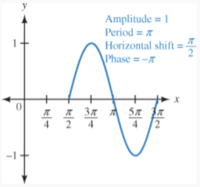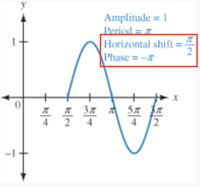In the book (Mckeague/Turner Trigonometry 8E) there is the following problem that asks for the phase difference.
[MATH]y = sin(2x - pi)[/MATH]
The
phase is described in the book as:
View attachment 23879
The image below shows that the line begins at [MATH]pi/2[/MATH] and that the Phase is [MATH]-pi[/MATH]. Using the definition above, it seems to me that the phase (difference) between [MATH]y = sin(x)[/MATH] and the graph here would be [MATH]-pi/2[/MATH] since the graph starts at [MATH]pi/2[/MATH], so why is this phase [MATH]-pi[/MATH]?
View attachment 23877
Unfortunately, the word "phase" is used in a couple different ways.
One is the actual
shift of the graph, which is
what you want it to mean here. In the form they are using, that would be
-C/B, because the function could be written as sin(B(x + C/B)), and replacing x with x + C/B results in a shift by C/B units to the left (that is, -C/B to the right).
What they are calling phase is the
relative angle in radians, which is given by C. Do you see that in this graph, the shift is half a cycle, which means half of 2 pi, namely pi radians? Note the phrase they use, "the fraction of a standard period of 2 pi", which is not quite accurate, but does try to tell you what it means. They don't use the word "shift".
This site calls -C/B the "phase shift", and calls C the "phase angle". I think this is fairly standard at an introductory level, though not in applications such as physics. The terms make sense: the phase shift is the actual movement of the graph itself; the phase angle relates to the sine function itself and its period, and is more important in applications. You just need to recognize which one they are talking about. Your book evidently just uses the one term, "
phase", to mean the
phase angle, which suggests it is oriented toward actual use.
When I teach this material, I have to check how the textbook uses these terms, and I generally explain these issues to clarify what they are and are not talking about. It's really tricky in tutoring when I don't have your textbook ...







